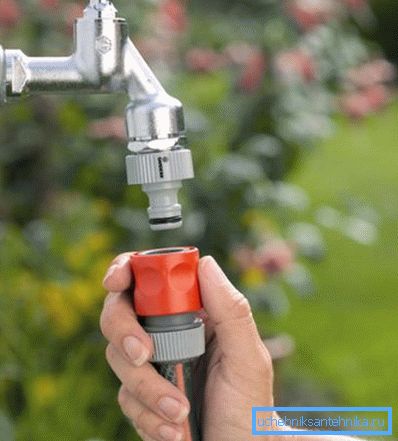Mixer with sensor: advantages, disadvantages, sample
How comfortable is the mixer with motion sensor? Where can it be used? Does this device have any serious flaws? We have to try to answer these questions and meet with several representatives of this class of sanitary equipment.

What it is
The mixer with an infrared motion sensor responds, as you might guess, to the movement of a human hand near its spout. On command from the sensor, the solenoid valve opens the ceramic valve and supplies water.
Optional features of the device that affect its cost are related to the flexibility of the mixer settings and the comfort of its use.
- The mixer can only be connected to cold water or to both pipelines.
To clarify: in the first case, it would be more correct to call it not a mixer, but an automated water inlet tap.
- Most models are available to pre-adjust the ratio of cold and hot water.

- The product can be equipped with a thermostat that maintains the required water temperature, regardless of the parameters of both pipelines.
- Finally, additional service functions may include a variety of fine filters, aerators, portable watering cans, etc.
To start the water supply, it is enough to place your hands in the zone of the sensor (1 - 30 cm from the mixer body). It is necessary to remove the hands - and after 5-7 seconds, the water will stop pouring. By the way, the response time to the signal from the sensor in the top models can also be adjusted.
The sensor and valve can be powered from a mains adapter with a voltage of 6-12 volts at the output or from a battery. As a rule, in the latter case, manufacturers promise a battery life of up to one to one and a half years.
Service, in addition to periodic battery replacement, includes periodic (approximately once every 2-3 years) lubrication of ceramic valve plates with silicone grease. Its leaching leads to an increase in friction resistance; the power of the solenoid may simply not be enough to switch the mode.

Advantages and disadvantages
Let's try to evaluate the solution we are investigating.
Merits
Their list is easy to find in any advertising brochure.
- Efficiency. Water consumption is dosed according to the real need for it. Do not turn off the water behind it is simply impossible.
- Great resource. With frequent switching on and off (especially in public institutions), any mechanic does not last long; here, mechanical effects on the sink mixer device are completely excluded due to the absence of external controls.
Note: all ceramic mixers are very sensitive to the large forces on the lever or wing. A sharp twist on the handle often breaks the cartridge stem, the plastic retainers in it, or the protrusions of the Cranbooks ceramic plates.
- Hygienic, important in public places. Nobody would touch the handle or lamb with dirty hands - they simply do not exist.
- Automatic temperature adjustment. Burn when using automation is impossible.

disadvantages
Without them, too, has not done:
- Low maintainability. If the majority of mechanical mixers are easily and effortlessly repaired with their own hands by replacing inexpensive mixing boxes or cartridges, then in this case the owner will have to contact the service if there is a breakdown. By the way, Grohe or Rotpunkt authorized services are not located on every corner.
- Price. It starts from 4.5 thousand rubles for devices with minimal functionality. The middle class is 10-15 thousand.
- The lack of fast and convenient temperature control for most models. When washing dishes, for example, it is convenient to make the water hotter, and when defrosting frozen meat it is cooler. Here it will take several movements instead of a single turn of the lever.
- When you want to collect a bucket of water, you have to remind the mixer every five seconds that you are still with it.
The obvious instruction: the only practical use of motion sensor faucets is washbasins. And mostly in public institutions.

Why not at home? It is all about the payback period of the mixer due to the estimated water savings.
The maximum savings per washbasin per month will take the maximum values - per cubic meter of cold and hot water. Believe me, relative to real numbers, the value is greatly overestimated.
The monthly savings expressed in money are approximately 120-140 rubles. Therefore, the payback period for a mixer worth 12,000 will be at least 100 months, or about 8 years. Note - excluding repairs, maintenance, the cost of lubrication (from 400 rubles per tube) and power consumption or replacement of batteries.
For family use project, you see, rather doubtful.
Samples
Let's explore several devices of the type we are interested in.
Oceanus art. 11-0190
| Parameter | Value |
| Material | Chrome plated brass |
| Sensor response distance | 25 cm with adjustable |
| Nutrition | 220V network |
| Cost of | 10608 rubles |

GROHE Minta Touch 31358000
| Parameter | Value |
| Material | Chrome plated brass |
| Nutrition | 6 V battery (included) |
| Functions | Cold water supply when sensor is activated by touch, automatic shut-off after 60 seconds, indication of battery consumption, retractable watering can |
| Cost of | 25989 rubles |
GROHE Veris F-digital 36278000
| Material | Chrome plated brass |
| Nutrition | 220 V network |
| Functions | Electronic control panel, wireless control of temperature and water flow, built-in thermal sensor, automatic shutdown after 60 seconds, reduced water consumption |
| Cost of | 53809 rubles |

Conclusion
We will consider our acquaintance with an unusual and, frankly, ambiguous decision made. The video in this article will traditionally offer the reader additional materials. Successes!